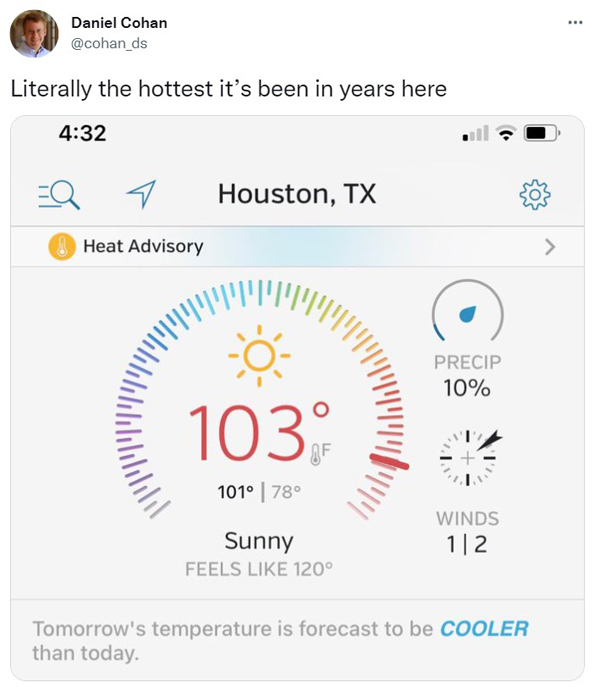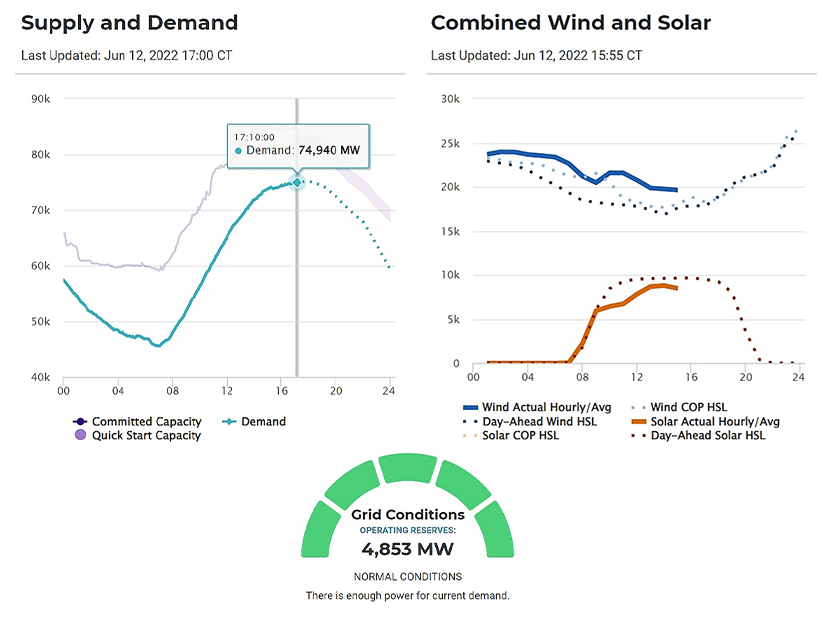Sweltering heat — even by Texas standards — led to ERCOT finally setting a new all-time peak demand mark Sunday after several close calls last week.
Demand reached 74.9 GW at 5:10 p.m. CT, breaking the previous record of 74.8 GW set in August 2019. The record could be short-lived, as ERCOT was projecting demand to peak at 76.8 GW on Monday, threatening staff’s peak demand forecast of 77.3 GW for the summer.
That the record came on a weekend, when offices are empty, and during June is an indication of how unusually hot the weather has been in Texas. The state’s major cities have set daily records for high temperatures since Friday as an oppressive weather pattern settled over the south central U.S. The National Weather Service issued an excessive heat warning for North Texas on Sunday in anticipation of temperatures above 105 degrees Fahrenheit and heat indexes above 110.
 The heat index in Houston reached 120 degrees at one point Sunday. | Daniel Cohan via Twitter
The heat index in Houston reached 120 degrees at one point Sunday. | Daniel Cohan via Twitter
The heat index was as high as 120 F on Sunday afternoon in Houston, where city officials activated the city’s emergency heat plan and opened cooling centers late last week. Austin also declared a heat emergency and opened cooling centers, where 100-degree temperatures are expected through next week.
“Welcome to the final days of spring in Austin,” tweeted University of Texas energy professor Michael Webber, sharing an image of triple-digit Austin-area temperatures (save for a 99-degree forecast for Wednesday).
Suddenly, ERCOT’s “extreme” maximum demand of 81.6 GW this summer doesn’t seem so improbable.
ERCOT has yet to issue a formal conservation alert. The grid operator still had nearly 5 GW in operator reserves during Sunday’s peak demand. Thermal outages were up slightly to 6.4 GW on Sunday, according to Stoic Energy President Doug Lewin.
The Texas grid was operating during the weekend under its third operating condition notice (OCN) since April. The OCN, intended to alert market participants of a possible need for more resources, was to expire Monday.
ERCOT officials have said they expect “sufficient generation to meet forecasted demand.” Indeed, the grid held up, despite scattered distribution outages in North Texas, lending a measure of comfort to Texans down on ERCOT since the disastrous February 2021 winter storm.
“Making it through this early heat wave should give some confidence in ERCOT for the rest of the summer,” said Joshua Daniels, an energy researcher at UT. “The bleeding has stopped; it’s time for rehab.”
ERCOT again set records for June when demand averaged 73.9 GW and 74.4 GW during afternoon intervals on Friday and Saturday, respectively. Demand exceeded 70 GW at 12:45 p.m. Monday.
ERCOT has benefited from wind and solar energy, though both at times have been curtailed by transmission congestion. The renewable resources were supplying about 28 GW of energy Sunday afternoon, some 3 GW below staff’s forecast. The cheap energy helped keep prices under $100/MWh Sunday, with the exception of the Houston load center.
According to a demand and energy report posted last week, wind (32.4%) and solar (6.2%) accounted for 38.6% of ERCOT’s fuel mix in May. Gas resources provided 32.1% and coal 13.3% of the energy mix.



